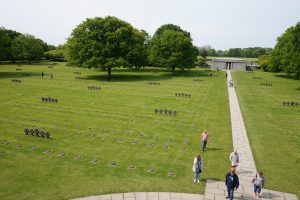Kate Greer
History and German, Class of 2020
The World War II sites that we visited in France hold massive significance in themselves in the events of the war. For this reason, they served as valuable historical sources that advanced our understanding of the war’s legacy Europe in multiple realms, such as loss of life, military advances, and France under occupation. One of Normandy’s biggest tourism draws as a region is the vital role it played in World War II. Our first place of residence was Bayeux, a quaint town equidistant from most war sites with narrow cobblestone roads, friendly inhabitants, and a beautiful ornate cathedral. By day, the little city was alive with visitors much like ourselves – on World War II pilgrimages.
Each day, our team ventured out to the numerous sites along the coast and interior that played important parts in the Battle of Normandy. Among these locations were the Caen Memorial Museum, St. Mere-Eglise, Utah and Omaha Beaches, Pointe du Hoc, Arromanches, and the American, British, and German cemeteries. As in London, members of our group presented site reports, which definitely augmented the profound effects that standing in these places created for students who have been studying the Second World War since the beginning of January.
It’s very easy to become desensitized to loss while sitting in a classroom, but when we came face to face with the vast cemeteries of Normandy, the thousands of soldiers, young and old, who ran into battle against the enemy were humanized. At these memorials, no one side is held above another; rather, the remembrances mourn all parties and lament violent death in such quantities. As I viewed and reflected on the tributes to both Allied and Axis forces, I gained great insight on their points of view that the lectures in my spring semester couldn’t really depict. Americans, Brits, French, and Germans either believed that what they were fighting for was right, went to war because there were no opportunities at home, or found themselves forced on to the battlefield against their will. Circumstances aside, we paid our respects to them all and memorialized the price they paid so the world might be free.
As we traversed the Norman terrain, our readings from General Dwight Eisenhower’s memoir, Crusade in Europe, helped me better understand the enormity and complexity of opening the second front in France. For example, walking next to towering hedgerows, exploring abandoned German defense bunkers, and viewing the rusting remains of Port Winston, the former Mulberry at Arromanches have all helped me visualize the Expeditionary Forces’ ability to solve problems on the go. They found innovative solutions that would efficiently use resources and minimize casualties, whether it was repurposing beach defenses to drill through thick foliage, developing new technology to breach the Atlantic Wall, or creating a temporary floating harbor that can withstand channel storms to unload supplies and bring in reinforcements. Eisenhower effectively described all of these undertakings in his recollections; however, viewing these sites in person has strengthened my comprehension of the logistical speed the Allies mustered to ensure victory.
After Normandy, we moved forward to Paris, the capital city and bustling heart of France. Paris was not a strategic communication hub for the Nazis or the home base for a collaborationist government. In fact, Eisenhower didn’t even want to bother marching through Paris as the Allies drove east towards the Siegfried Line. Spending three days in the city taught me why Paris was so symbolic to the French people that its liberation from the Germans is considered a triumphant moment in their country’s history. Paris is the summit of French culture, history, and character, and a foreign entity swallowed and humiliated their national identity for nearly five years. As I strolled along the Seine, people-watched in a café, and moseyed through art museums, experiencing the sights and feelings of French-ness for myself, I tried to imagine a constant hostile presence in Paris, infiltrating the culture and stealing neighbors away in the night, as Jean-Paul Sartre described in “Paris Under the Occupation.”

Leaving a note at the Angoville au Plain Church for Dr. Robert Wright, an OSU Alum, who opened a clinic for wounded soldiers on all sides.
As historical sources, Parisian museums and monuments seemed to contradict many of the points we learned about the Fall of France in Dr. Mansoor’s History of World War II lectures this past semester. Dr. Mansoor cited evidence of poor military leadership, stringent doctrines of methodical battle, and social and political tensions throughout the country to explain why France surrendered to the Nazis in June 1940. Other the hand, the French Army Museum argued that France never did fall because the Maginot Line – their immobile armored border protections in Alsace-Lorraine – itself never fell. The wording used in museum exhibits throughout France seemed to ignore that France was at one time defeated and place itself among the victors of the war.
French historical memory and presentation, from what we witnessed, is overwhelmingly focused on World War II as a struggle to defeat the Nazis in their country. Their museums and memorials glorify France, idolize General de Gaulle, and acclaim the Resistance to a point where it became hard to distinguish accurate accounts from patriotic stories. In the end, we each had to make decisions to discard the French interpretation of their own national war experience, or simply accept what was presented to us as history.








